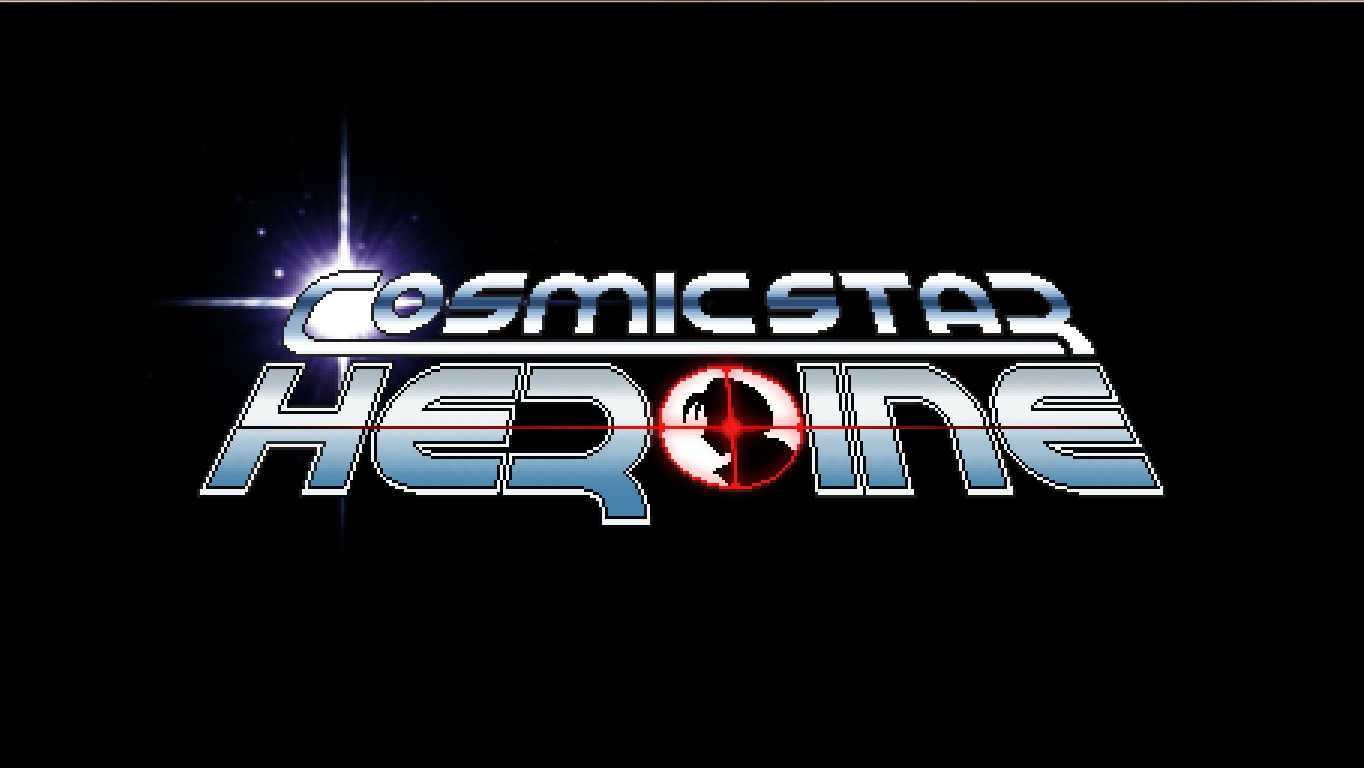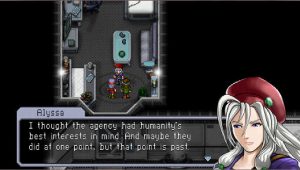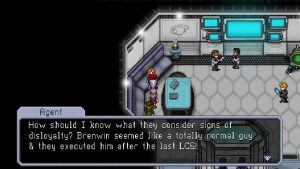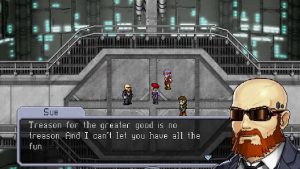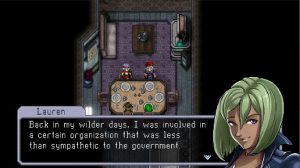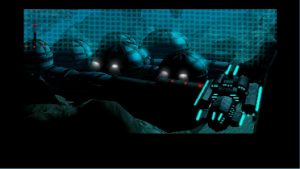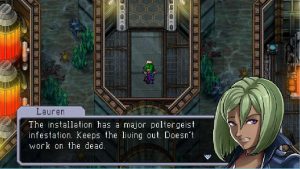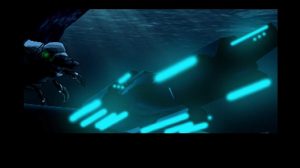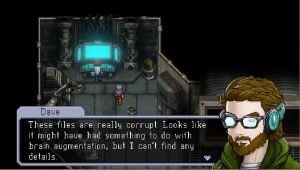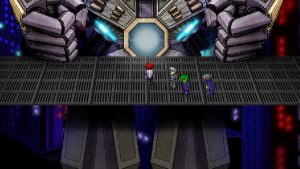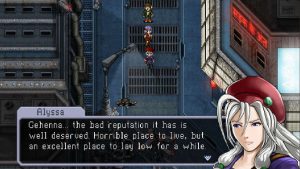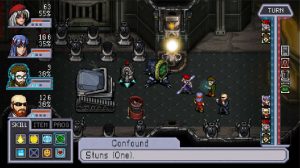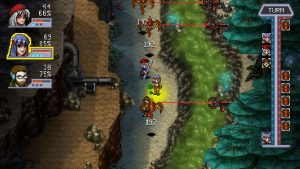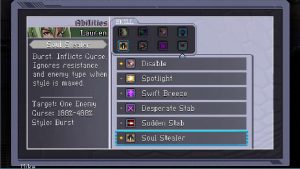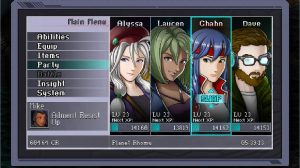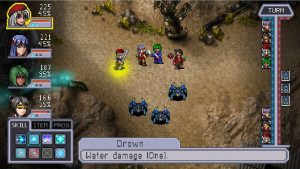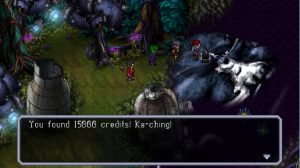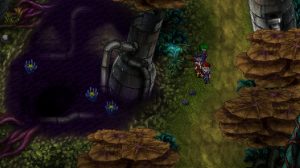I absolutely loved the idea of Cosmic Star Heroine as pitched in Zeboyd Games’ 2013 Kickstarter campaign: a neo-JRPG that marries Chrono Trigger with Phantasy Star, and blesses the resulting fusion with serious turn-based mechanical depth and a modern 16-bit presentation. It’s a title I’ve wanted to like from the day it was announced. And now that Cosmic Star Heroine (CSH) is finally here, the resulting package is unquestionably an impressive accomplishment – especially for a two-man team. (They of Cthulhu Saves the World.)
Yet I’ve come away from playing CSH with mixed feelings. Cosmic Star Heroine’s innovative combat system handles really well and offers a subtlety and complexity that will satisfy the seasoned 21st century gamer. Its visual presentation is top-notch and its original soundtrack is superb throughout. CSH’s animated cutscenes are gorgeous and certain to deliver oodles of cool each time, every time. However, I find that the game disappoints in the narrative department. Its story is not particularly well-delivered, personalities never develop beyond skin-deep and, perhaps most regrettably, Cosmic Star Heroine fails to make good on the abundant thematic potential of its sci-fi cyberpunk setting.
In Cosmic Star Heroine, you take on the role of Alyssa L’Salle, a covert operative in the employ of the nebulous Agency for Peace and Intelligence, or API. That’s a pretty serious profession for happy-go-lucky, fashion-conscious twenty-something, for the API is both the supreme law enforcement institute on the planet Araenu and the designated custodian-developer of highly advanced cyberpunk-esque neurological and robotic technology that mustn’t fall into the wrong hands. With a pristine service record that includes saving the world on at least one occasion, Alyssa and agency pals Chahn (a chipper, sportsy Gunmancer) and Dave (archetypal hackerdude who spends his days glued to an iPad) seem destined for a lifetime under the API’s wing. After all, there can be no cause greater than working for the common good, and API’s rallying cry that explicitly includes liberty and equality implies precisely such a mandate. Or does it?
Cosmic Star Heroine leads off with an offworld mission to the exotic planet of Rhomu. Here, the seed of doubt is cultivated surprisingly quickly in Alyssa’s mind. Rhomu is awash with the relics of now-outlawed supertechnology from the last galactic war, and she considers the API’s orders to retrieve an artifact called the Lumina Device inherently suspect. Upon their return to the agency, Dave dregs up a batch of audiotapes logged by API Director Steele in which he readily reveals his stated ambition to revive the dormant Project Lumina, which the trio – with surprising swiftness – construe to be a probable nation-wide brain augmentation control scheme. Explicitly championing free will as the greatest good in a short 15-line dialogue sequence, and casting Steele’s plans as an obvious and irreversible impediment to it, Alyssa, Chahn and Dave immediately resolve to transfer the mantle of morality guardians from the agency to themselves and go rogue. And with that, you have CSH’s premise: it’s the Alyssia squad vs. the API; David vs. Goliath.
Note: this review dedicates ample space to what I think is the game’s unimpressively constructed story and (want of) thematic exploration. If you don’t care about this and want to read about the excellent gameplay instead, skip to here.
Right, so the cast goes rogue to challenge the API. Of course this is not the end of the matter – Cosmic Star Heroine wouldn’t be a true RPG if there weren’t at least one major plot twist down the road. But for a good many hours, the aforementioned 15-line conversation is literally the full narrative setup that CSH labours under, making its premise at best wafer-thin. In principle this is fine – characters have embarked on epic quests for less – but what bugs me is that CSH shouldn’t be that game. Cosmic Star Heroine is not Dragon Quest; rather, it aims to be an explicit reinvention of Chrono Trigger and/or Phantasy Star.
Yet CSH establishes neither its narrative nor characters very well, the latter written to readily abandon their entire lives – no, place themselves in mortal peril – without any serious exploration of their motives nor risk assessment. Essentially, Alyssa, Chahn and Dave present absolutely no evidence of ethical qualms in turning on their former handlers. Nor do they express the remotest concern for personal safety in face of taking on an evidently omnipotent organization whose operatives are repeatedly, explicitly described as galactically competent at eliminating anyone, anywhere, at any time. (One agency staffer even casually comments that API’s apparent lackadaisical cybersecurity is no real hazard to the agency’s covert nature, since anyone burgling its systems would be assassinated on its instructions before they could say ‘Cosmic Star Heroine’.)
Sure, we – the player – learn from typical NPC chatter that the API run a tight ship. For one thing, they uphold a zero-tolerance transgression policy whereby ‘disloyal’ agents, whatever that means, are disposed of in euphemistically named Loyalty Cleaning Sweeps, so Alyssia and pals have some reason to question their long-term well-being under the API umbrella. But oddly they don’t pause to ask themselves – or anybody else – any questions in the lead-up to their defection. The API’s track record is not factored into the 15-line life-changing conversation, nor do they approach Steele and/or other bigwigs for clarification on Project Lumina. And the dangers of the Lumina Device are also not made explicit. Presumably Alyssa and friends have knowledge of its devastating effect in past wars, but we, as players, receive little exposition to help us understand the madness of Steele’s ostensible plans. Altogether, then, it’s a bewildering premise that had me scratch my head from the get-go.
Now, you might argue that such rashness is expressive of Alyssa and Chahn’s personalities. They don’t fear the agency because they, as automatons designed to operate and survive in the shadows, embody it. And an unimpressionable attitude is certainly befitting of fearsome elite agents in the tradition of Jason Bourne, as is a potential tendency to shoot first and think later; to act instinctively rather than cerebrally. But frankly, I don’t find that explanation convincing, because the group contains tech wizard Dave, a thinker who’d you expect to pose hard questions and tear apart ill-conceived impulsiveness. But no, Dave is on-board instantly and just smirks slyly at the prospect of exile, posing no opprobrium to the plan nor admonishing caution.
In fact, I found no good narrative justification for the cast’s insane decision to defect based on a collection of mildly troubling audiologs and hearsay about a vagueishly dangerous device. And that’s a pity, because the lack of a sound premise devalues literally everything that happens after the opening scenes because I just couldn’t friggin’ understand why their were doing what they were doing. I started thinking that another explanation had to exist why Cosmic Star Heroine resolved to suspend its central premise in mid-air, no struts attached. And there does indeed: CSH seems to handle (all of its) story beats with a characteristic hurriedness, because more than anything else, it is absolutely terrified to be slow.
Instead, CSH is quick. It wants to be quick. Specifically, it wants to be a fully-fledged RPG in a third of the usual time, aspiring to pack an elaborate story into an experience shorter than Chrono Trigger (CT), clocking in at 20 hours tops. This desire to be “respectful of your time” was an express Kickstarter selling point; the showcased formula for a 21st century neo-(J)RPG. But this is wanting to have your cake and eat it: when moving along an RPG at the clip of an action film, the narrative side has got to give – and it does. Characters must be impulsive and gung-ho, for CSH’s overriding concern with brevity affords them no room to be anything else.
One consequence is that virtually no time is allotted to character development, rendering avatars stagnant snapshots of backstory-bereft personalities. Cosmic Star Heroine cleverly compensates by building an effective wisecrack chemistry between Alyssa, Chahn, Dave and fourth rapid addition Lauren that makes you forget their individual anonymity. I happily got a good few giggles out of their conversations, but still wanted the central cast to converse with each other to elicit motivations and histories – to find out what made them tick – but that doesn’t happen in CSH.
In the meta-narrative, however, Cosmic Star Heroine’s central concern with speediness opens gaps that are harder to smooth over. As said before, CSH doesn’t permit itself to widen the base of its premise to full satisfaction, going in guns blazing before establishing who and what really matter, and why. And once it starts going, there’s no stopping the runaway train as twists and turns continue to tumble over each other, Indiana Jones-style. I don’t like this much. The practical result is frequent poor rationalisation for in-game decisions that punctures the suspension of disbelief in the inquisitive player’s mind. I’ll give one low-spoiler example: an early-game scene inside a submarine rebel base. I still don’t really understand what happened since so much shit went down simultaneously, but the reconstructed picture is something like this.
So, upon making contact with the rebel organisation known as Astrea, Alyssa & pals enter their aquatic sanctuary “Leviathan”, which doubles as base of operations and refuge for disenchanted ex-API personnel. Thanks to a protective force field surrounding it on all sides, the installation has remained untraceable, hidden in plain sight from the API. Despite tales of its legendary security, however, Leviathan is inexplicably attacked overnight by an API fleet of submersible ships. Managing director Arete responds by imploring Alyssa not to mount organised resistance, but to actually go out and lower their defences.
Now for the confusing part. Initially it wasn’t at all clear to me why the force field should go down. To self-destruct Leviathan and blow the API troops and ships to smithereens with it? (Seems sensible.) Or does the plan somehow pull in the aggressive seamonsters inhabiting the seas around Leviathan that Arete keeps talking about, and which the ringfence is designed to repel. As I was trying to figure this out, talk suddenly emerged of ghosts (yes, ghosts) and a long-standing poltergeist infestation. Rrrrright. I then ended up fighting these dragon-shaped ‘poltergeists’ while trying to access the force field’s power generators, whose control switches were somehow miles removed from Leviathan’s main PC hub despite that terminal offering manual control of literally everything. (Including, according to one NPC, oxygen levels.) Okay.
Shortly after I finished doing this, the deus ex machina of a giant seasnake materialised from the oceanic depths and decided – of all potential targets – to wrap itself tightly around the API flagship. Steele and crew then for some reason abandoned their priceless vessel rather than fighting off the monstrosity, which prompted Alyssa, Arete and consorts to beam over – I think – and take control of it. I still have no effin’ idea how they subsequently managed to scare off the giant seasnake tearing the ship to bits, but after halting Steele’s self-destruct sequence they immediately, without warning, flew off into space. Because, you know, pigs submersibles can fly.
I’m still left scratching my head about all this. First off, what purpose did the force field serve in this lucky escape? Did it somehow purposely enrage a very specific gargantuan seasnake? Was it a precondition for even leaving the base? I don’t really know, because I wasn’t told. Nor do I see how Arete could possibly have had Kasparovian clairvoyance and seen five moves ahead in the face of extreme unpredictability, but maybe I’m missing something. If anybody has figured it all out, I’d love to see a breakdown.1I appreciate the narrative purpose this switcheroo plot device serves – hurray for interplanetary travel! – but as I played through this 30 or so minute section of the game confusion reigned supreme as I wondered what the hell I was doing.
Anyway, besides character credibility and narrative clarity, Cosmic Star Heroine’s murderous pace also compromises the space of its ideas. Since CSH opt for futuristic cyberpunk, its setting brims with thematic potential. Early on, the game promises to make good on some of this by teasingly toying with the concepts of bionics and the biological singularity as we encounter the shells of long-dead organic lifeforms reanimated by robotic creatures. After this stage-setter, however, this theme is dropped and abandoned. Other tantalising subjects that merit exploration pop up from time to time, such as the freakish alien races that appear in the game (giant green cats!) and the obvious surgical modifications everywhere. (One dinner guest hilariously laments not fitting a third stomach prior to sitting down for a particularly scrumptious meal.) But these receive only the most superficial of treatments.
Of course I won’t judge Cosmic Star Heroine for not indulging the extravagant philosophical detail of major first-party RPGs like Mass Effect and Nier: Automata, as that requires resources easily beyond the means of a crowdfunded two-man team. But I do judge it, however, for so patently ignoring the juicy opportunities to trawl the themes directly embedded in its very premise. Surprisingly, the cast never even pauses to truly discuss the Lumina Device and its tainted history and possible societal implications, this despite founding their entire rebellion on it. CSH has 15-odd hours to explore this subject – plus some bells and whistles of cyberpunk, Mass Effect-style – but literally doesn’t do any of it. This means that we’re never even exactly sure why Alyssa and friends oppose API’s aspired central role in reforming society with the use of the Lumina Device. Is it because no person or corporation should hold this much unfettered power? Is it because good intentions may go sour, causing the device to be used for evil? Is it because some third party may get hold of the device, using it for their own ends? Are the nebulous status of the API and Director Steele the specific problem? Or is it, after all, solely about ethical objections? I don’t know. I played for a solid ten hours, and CSH never elaborated.
Often, then, I wished CSH would slow down a little to sprinkle around more flavour snippets and be a little less rollercoaster, to embrace longer lead-ups and world-building to preface fewer twists. Having played through most of the game, I couldn’t shake the impression that much story bulk was, first, compressed down and trimmed to size 4-lean and that, second, whatever remained was deliberately moved outside of the main dialogue sequences to instead allocate the tidbits that grant some life to Araenu to a dense network of skippable NPCs plastered across its maps. I’m aware that no game an satisfy all audiences at once. There is certain to be a subsection of players – perhaps even a majority – who appreciate thunderous pace of CSH’s action; who want Akira, not Blade Runner. Personally, however, I yearned for a more profound interfacing with CSH’s environs to feel more than a passerby in a world with so much, yet so clearly underexploited narrative potential.
Right, let’s set the criticism aside for now and focus on the good stuff. So if Cosmic Star Heroine isn’t strong narratively, should you still play it? Oddly, my answer is yes. The combat system is fantastic and its art style is gorgeous (more on those below). But you should also play it because CSH is absolutely jam-packed with cool stuff. The kind of cool where a Godzilla-sized mech is airlifted into the heart of town to commence violently deconstructing his surroundings. The retro-cool of its faithfulness to Chrono Trigger through a Millennium Fair recreation, replete with mini-games, a trademark selection of kittens and dance corner supervised by DJ-ing, Daft Punk-esque robots to rival CT’s tribal conga band.
But especially the kind of cool of Gehenna, a district on western fringe of Araenu (your starting spacerock) that looks very much the way I imagine Night City in William Gibson’s Neuromancer to look: shady personalities populating a grimy warren of back alleys amidst mixture of neon-bathed storefronts advertising both tools for dirty jobs and cybernetic implants, abandoned buildings littered with antiquated tech, and futuristic ero-bars serving equal parts illicit Milk+/MilkPlus and the old in-and-out in dimly-lit backrooms. Okay, maybe that last part is overly Clockwork Orange for CSH, which keeps it fairly clean (although a bar customer does order a suspicious pint of unspecified milk), but Gehenna is nonetheless an awesome amalgam of dystopian cyberpunk influences. And I won’t spoil it, but you’ll find a ridiculously awesome animated concert scene at Gehenna’s local watering hole, the Nightshade, that saw me grinning ear to ear. I lament that in a perfect world, this 16-bit ‘hard’ cool would seamlessly co-exist with the ‘soft’ cool of exploration of cyberpunk themes. Ah well, a man can dream.
—
Right, somehow, that’s ended up as 2,500 words on Cosmic Star Heroine’s writing – quite a lot more than I had intended. I’ve probably already revealed more story specifics than you’d want from a review, so I’ll refrain from giving out any more. So instead let’s turn to look at gameplay, and in particular the superbly crafted, well-paced combat system that will occupy the majority of your time in the game.
Here Cosmic Star Heroine appears to take a clear leaf out of Chrono Trigger’s book, but this likeness is only superficial. As in CT, foes visibly roam the map you’re traversing, and making contact with them triggers a battle there-and-then, without loading into separate combat screen. (It also means that with skillful manoeuvring, like in CT, it’s possible to dodge a small proportion of fights.) Again like in CT, foes have elemental weaknesses that can be exploited. That’s where the similarity ends, however, as CSH does away with CT’s hybrid real-time battling formula in favour of firmly turn-based combat that is less frantic and widens the scope for strategy.
Because random encounters are neither ubiquitous nor RNG-reliant, each battle is a bespoke micro-challenge in a web spanning the game from start to finish. This is especially true on the well-calibrated Heroine difficulty, which I heartily recommend. This transfer of decision-making power to the player – do I take every fight or progress the story faster? – is an approach to RPG gaming that feels welcomely modern. And you can save anywhere at anytime, too.
Let’s dive into the nitty-gritty. Battles themselves pivot on character-unique abilities. There are no such classic commands as ‘attack’, ‘defend’ or ‘magic’. Rather, each turn, an avatar will use one of eight skills available to them. Bearing names such as Inspire, Laser, Flood, and Knock Out – to take Alyssa for an example – these may boost an ally’s (or self) attack stat for 3 turns, fire an armour-piercing laser at a single target, drown all enemies in elemental water damage, or inflict a status condition such as a one-turn stun. A single use burns through that ability, and a character must skip a turn to reset their cooldowns. The obvious trick to eliminating foes quickly and efficiently is to sequence abilities for maximum firepower. For instance, many robotic enemies resist water damage poorly, so my go-to, highly effective yet unspectacular strategy was to double-boost Alyssa’s attack with skills and an item, inflict the ‘vulnerable’ status to lower a robot’s defence, and then initiate Drown for a massive deluge.
While this is Cosmic Star Heroine‘s bread and butter, the system sports quite a few unique touches, most notably the gentrified attack modifier called Style. As a battle progresses all combatants, including enemies, build up style by using their various abilities. The higher one’s style, the greater the multiplier on a skill’s base damage output, and the better the odds of inflicting status conditions. Another is Hyper Mode. As turns go by, each character will gradually fill out a meter in 2-5 turns to reach the bright yellow aura that indicates critical mass, causing whatever ability you deploy that turn to be extra effective. Needless to say, launching a coordinated, all-out Hyper Mode attack under the influence of stat buffs and enemy vulnerabilities can have devastating results. On Heroine difficulties and up, constructing such synergies is imperative, as enemies pack a real punch and will grind you down if left unchecked.
Lastly, a few hours into the game various ‘support’ characters are unlocked back at base who combat confer bonuses via comlink, such as stat boosts or better item effects. Interaction with this person is limited to a portrait selected on the menu screen, but their effects are nonetheless profound since, say, the option of activating 15% ailment resistance is an absolute boon in a dungeon where every single enemy appears hell-bent on stunning – i.e. fully disabling – you for a turn, each turn.2CSH also introduces Desperation Mode, a feature that allows characters’ HP to fall negative under certain conditions. It’s a double-edged sword since sub-zero HP amps up attack damage, but a failure to re-establish positive HP results in full-on knock-out. I imagine a highly skilled player can dance around this mechanic to spectacular effect, but for myself this gimmick’s risk-reward ratio swung in the wrong direction.
It’s also worth mentioning that items are not in fact consumables, but permanent acquisitions selectable for battle that, much like abilities, can be used only once per encounter (and do not recharge for its duration). This similarly applies to equipment-specific special powers, or Programs. Much like regular abilities, items and programs can do anything from buffing and debuffing to damage and healing. CSH’s combat layers thus run three-deep: abilities, items, and programs. Its mechanical depth easily exceeds Chrono Trigger‘s, and is perhaps the biggest point in favour of CSH’s originality. Tangoing with this combat complexity is very satisfying, particularly on Heroine and the ultimate Super Spy difficulty where each encounter is akin to an intricate chess-like puzzle beckoning to be solved.
By and large, then, this system is fun and works excellently. Sure, there definitely are optimal strategies that are borderline game-breaking on the initial difficulties. The game, however, recognises this potential for staleness and responds by mixing up your party a lot. While not always rationalised convincingly from a narrative viewpoint – “I need to go take care of some errands” (Sue leaves) – the gameplay merits are clear, as it keeps you from rinse-repeating winning strategies with a fixed cast, instead forcing you onto the back foot to optimise whatever avatars you’re presented with at that moment.
To this end the game presses into service a cast of allies that periodically drift in and out of the party. This includes wondrous creations such as Psybe (giant cybernetic insect) and Clarke, a robotic dancing automaton and part-time casanova clearly styled after Freddy Mercury who waltzes his way into your party unsolicited. With the final tally resting at a dozen-ish rotatable allies, CSH slots in comfortably between Chrono Trigger and Chrono Cross in levels of party customisation. And despite the now familiar refrain that each of these characters contribute regrettably little to the advancement of plot, their individual arsenals of a dozen-plus unique deployable skills renders the gameplay combinations nigh-infinite. You will develop favourites and uncover OP strats, but the game’s countermeasure to periodically deny access to them is rather effective at making you try new things.
That said, at times I felt arbitrarily strong-armed into a deliberately underpowered party. This reached its peak when I was saddled with both the sub-par briefcase-bureaucrat “Sue” – he of the treason quote – and the above niche support Freddy Clarke. This stripped my party of half its usual damage potential and devolved battles into sheer tedium – not strategic challenge – for a while as I was forced to rely nigh-exclusively on Alyssa to crank out respectable numbers. And as though suddenly alarmed by its own breakneck pace, this happened a few more times as the game advanced, thereby curbing your pace through the final few areas by (temporarily) striking powerhouses such Arete and Psybe from the roster.
A final comment I want to make on Cosmic Star Heroine’s design choices concerns the treasure chests in the game. These are scattered across maps just like in CT – or the vast majority of RPGs ever, for that matter – but all too frequently contain just copious quantities of unexciting, entirely superfluous credits (Gold) rather than the thrilling new equipment or items you might hope to find. Since this sameness obviously results from the unorthodox yet successful decision to drop consumables – an immutable tenet of the RPG formula since time immemorial – in favour of persistent items, I want to highlight this as an observation, not a point of critique. Frankly CSH’s combat works splendidly without consumables, their absence noticeable only outside of it in the barrenness of said chests and excess quantities of credits piling up in my bank account, with too little to spend it on.
—
Finally, Cosmic Star Heroine paints its narrative and combat system against a gorgeous 16-bit aesthetic built around vibrant violets and neon-blues contrasted with many shades of inky blackness. It’s very pretty look indeed, and the beautifully crafted animated cutscenes – which are modelled after the Sega CD era – draw on the same colour palette to breathe life into the game’s more momentous events.
Both are supported throughout by an excellent atmospheric original soundtrack routinely reminiscent of Phantasy Star. In particular, the bionic facility on Rhomu instantly evoked PSO’s “Empty Space Out Of Control” (the Mines theme), while the aquatic Leviathan track somehow called to mind KoTOR’s Manaan. The OST sufficiently impressed me that I looked up the creative team responsible, and I soon landed on the website of Hyperduck Soundworks, who also scored the ambient, moody soundtrack of Dust: An Elysian Tail. They’ve done an excellent job here.
Let’s go full circle to round off this review and revisit the appropriate yet entirely unfair comparison with demi-mythical Chrono Trigger. As the inspired product of 20-odd years of gaming evolution, Cosmic Star Heroine’s combat system is the game’s beating heart and – together with the game’s abundance of cool and a gorgeous, slick aesthetic – the chief reason to pick it up. In all of these departments, it rivals Chrono Trigger as a potential 21st century classic. The biggest threat to this aspiring status, however, is CSH’s narrative yield, which is markedly less rich than CT’s and frankly substandard for a game that aspires to be an RPG first and a strategy game second. Narratively, Cosmic Star Heroine unfortunately fell entirely flat for me.
All in all, Cosmic Star Heroine is a wild ride that offers up a veritable grab bag of smile-inducing cool moments, yet all too often feels like an eclectic compilation of greatest hits starved for the glue that binds it all together. Much like many fiery explosions are rarely the optimal recipe for a rewarding Hollywood movie, Cosmic Star Heroine struggles to back up its sheer abundance of individually impressive set pieces with a meaningful overarching experience, paying the price in cohesion as the gameworld regresses into an isometric vehicle for an action-packed plot rather than a universe unto itself.
Insofar as this problem is rooted in an overriding concern with pace, one might conclude that CSH shoots itself in the foot. Zeboyd Games may have misconstrued what it means to be “respectful of a player’s time”, which is not to rush a story, but to take ample time to nurture and develop an RPG’s narrative so that it propels the game’s every second forward. Certainly, CSH is respectful in raw numerical terms, but in so doing lacks the rich narrative fluff in which to cocoon its fantastic combat mechanics, causing them to ultimately go stale.
Each minute spent with CSH therefore feels under-enriched, making for a per-minute payoff lower than its hypothetical lower-octane version with a better rounded story, more character interaction, and some exploration of sci-fi cyberpunk themes. Throughout the Kickstarter campaign I was excited to see what Cosmic Star Heroine might become, but for all its mechanical strengths and impressive polish I can’t help but come away disappointed now that it’s here. Cosmic Star Heroine is a fine, at times impressive game, but in the fullness of time will find itself hard-pressed to live up to the greatness of that awe-inspiring monument of gaming – Chrono Trigger.
- Harvest Moon 3 (2001) - March 5, 2020
- Pokémon Trading Card Game 2 (2001) - February 5, 2020
- Yu-Gi-Oh! Dark Duel Stories (2002) - January 5, 2020

